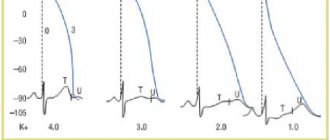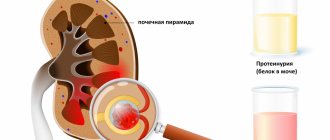K is the main cation of intracellular fluid, which contains 98% of the potassium of the whole body. The cation ensures osmolarity of the cytoplasm and creates conditions for biochemical reactions to occur in it. The entry of K into the cell through the plasma membrane is determined by many factors. Potassium channels provide passive permeability of the membrane for the cation, while the movement of K is determined by the magnitude of the electrical potential and the concentration gradient. Potassium channels can be in an open or closed state; the passive flow of potassium into the cell is determined precisely by the number of currently open channels. The high permeability of cell membranes for K, especially in a state of excitation, and “relative impermeability” for Na, leads to the emergence of a potential difference on the plasma membrane.
The stability of K content in the body is a consequence of balancing the processes of its intake and excretion. The intake of K from food is most important in the regulation of the total cation pool. An adult consumes 80–100 mmol K daily. From 85 to 90% of K taken in food is excreted by the kidneys. In the absence of K in food, 40–60 mmol/day is excreted in the urine for several days, after which the loss of K in the urine decreases to 10–20 mmol/day. 10–15% of K consumed with food is excreted through the gastrointestinal tract. This pathway of cation excretion may be enhanced in conditions of mineralocorticoid hypersecretion and renal failure. A significant amount of K can be released through the skin only in case of intense sweating.
Cells of the nervous and muscular systems quickly respond to a decrease in plasma K levels, which explains the early appearance of symptoms - muscle hypotension, weakness and asthenia, weakened reflexes. Some cases of hypokalemia lead to symptoms of paralysis and even rhabdomyolysis. Severe hypokalemia is accompanied by disturbances in conduction and rhythm of cardiac activity, which is reflected in the ECG (decreased wave amplitude, T wave inversion, widening of the S-T interval and the appearance of a U wave). With chronic K deficiency, the size of the heart increases, rhythm disturbances occur, and with a sharp decrease in the level of K in the plasma, cardiac arrest in systole is possible.
Symptoms of hyperkalemia depend on the rate of increase in the cation content in the plasma and are associated with changes in the membrane potential of neurons and muscle cells. Neuromuscular symptoms of hyperkalemia are expressed in paresthesia, and in more severe cases - in ascending paralysis of the limbs. The severity of cardiac symptoms depends on the degree of increase in plasma K - from minimal ECG changes to serious rhythm and conduction disturbances (transverse block and ventricular fibrillation). When the K concentration is above 6 mmol/l, as a rule, ECG changes are detected (sharpening of the T wave, lengthening of the P wave and P-R interval, widening of the QRS complex, elevation or depression of the ST segment), which become more and more pronounced as hyperkalemia progresses. At a K level above 7 mmol/l, the development of cardiac arrhythmia with a fatal outcome was noted; at a K concentration above 10 mmol/l, the heart may stop in diastole. In the clinic, prolonged hyperkalemia is most often a consequence of chronic renal failure.
How to lower potassium in the blood quickly and effectively
Therapy of hyperkalemia involves the use of sodium zirconium cyclosilicate. The Committee for Medicinal Products for Human Use of the European Medicines Agency has approved its effectiveness and efficiency in diabetes mellitus, renal failure and heart disease. According to the results of a pilot study, 98% of patients were successfully treated with this drug. At the same time, the duration of remission lasted up to 12 months.
The active removal of potassium from the body is facilitated by stimulation of the intestines when creating a positive osmotic gradient. To do this, the doctor prescribes gastrointestinal dialysis to the patient with the following solutions:
- magnesium sulfate;
- oil emulsion;
- ion exchange resins;
- various sorbents.
A single procedure is not enough for effective treatment. The effectiveness of therapy is evidenced by a decrease in the severity of symptoms of hyperkalemia and a decrease in the concentration of ions in the blood serum.
It should be noted that in order to normalize the indicator, it is necessary to identify the reason for its increase. Treatment of the pathology will lead to an improvement in the patient’s condition and restoration of the normal balance of potassium ions in human cells and blood serum.
2. Reasons
It would be logical to assume that hyperkalemia is caused by excessive consumption of potassium-rich foods, for example, dried fruits, legumes, potatoes, bananas, etc. However, in reality this is extremely rare: the body’s daily need for potassium is quite large (up to 5 g in adults), and with normal metabolism the balance is easily restored through the excretion of potassium in the urine.
Thus, one of the main factors in the development of hypercalcemia is disorders of the kidneys (chronic renal failure, diabetic nephropathy, etc.), when potassium excretion becomes difficult and it begins to be retained in the body. This can be caused, in particular, by hypocorticism (Addison's disease) - chronic functional insufficiency of the adrenal cortex, in which the kidneys simply do not receive the appropriate hormonal “commands”.
Another group of reasons is associated with long-term use of medications that contain potassium or prevent its excretion.
The massive release of potassium from cellular fluids into the bloodstream is accompanied by severe polytrauma with crushing of large volumes of muscle tissue, drug overdose, and extensive burns.
The progressive accumulation of potassium in the body can also be caused by pathologically rapid and intense hemolysis (decomposition of red blood cells) in anemia and some other diseases.
Rarely, hereditary hyperkalemia is recorded - familial hyperkalemic periodic paralysis.
Visit our Therapy page
1.General information
Potassium is one of the key macroelements in the human body. This substance, especially in interaction with sodium, is necessary for the regulation of contractile activity of muscles (including the myocardium), water-salt, acid-base and energy balance, higher nervous activity, normal fermentation and metabolism, secretory activity of the endocrine glands, functioning liver and kidneys. Up to half of all salts in the body are potassium compounds, and most of them are contained in intracellular liquid spaces.
For all micro- and macroelements, including potassium, a certain concentration range must be observed.
Otherwise, both deficiency and excess lead to the development of severe, sometimes life-threatening conditions. Hyperkalemia, i.e. Excessive potassium levels are a typical example.
A must read! Help with treatment and hospitalization!
4.Treatment
With moderate and severe severity, hyperkalemia requires emergency intensive care due to the threat of cardiac arrest. One of the emergency measures is the intravenous administration of a special solution (calcium, insulin, glucose), but its effect is short-lived, and after relief of life-threatening symptoms, further therapy is required. Potassium-absorbing sorbents are prescribed (which ensures its excretion in feces); diuretics are used if renal function is preserved. Stop taking any medications that in one way or another affect the circulation of potassium in the body. Limit potassium intake from food. Since hyperkalemia is almost always secondary, a diagnostic examination (if the cause of the detected hyperkalemia is unknown) and treatment of the underlying disease are mandatory.
What does it mean if potassium in the blood of an adult is elevated?
Increased potassium in the blood is referred to in medicine as hyperkalemia. The potassium value in a laboratory analysis for hyperkalemia should be 5.2 mmol/l or more. A severe form of this condition requires emergency medical care for a person. Because it poses a danger to the proper functioning of the cardiovascular system.
The normal level of potassium in blood serum for an adult is from 3.4 to 5.2 mmol/l.
Up to 98% of the macroelement in the human body is concentrated inside cells, the remaining part (2%) enters the extracellular fluid and bloodstream. Maintaining the membrane potential of cells is possible only with a balanced content of potassium and sodium ions.
The need for potassium, as one of the most important macroelements, lies in its role in the following processes:
- maintaining the potassium-sodium pump to ensure the transmembrane potential of cells;
- creation and maintenance of homeostasis;
- transmission of nerve impulses and action potentials in nerve cells.
Therefore, any deviation of the indicator from the norm, up or down, affects the above processes.
An increased level of potassium in the blood indicates a violation of the process of its removal from the body. The macroelement is excreted in the urine after filtration and reabsorption in the kidneys, sweat glands and along with feces.
Read further: Table of potassium levels in the blood for women and men
Pathological causes of increased potassium
Let's take a closer look at what pathologies are indicated by increased potassium in the blood.
Kidney failure
In acute or chronic forms of renal failure, potassium ceases to be fully excreted from the body and begins to be deposited. In this case, the active parenchymal tissue of the kidneys is destroyed and replaced by connective tissue. Diseases leading to kidney failure: pyelonephritis, urolithiasis (kidney stones) or glomerulonephritis. Less commonly develops against the background of diabetes mellitus or atherosclerosis. The treatment regimen is drawn up exclusively by the attending physician and is aimed at eliminating the cause that provoked renal failure.
Adrenal glands
Chronic insufficiency of the adrenal cortex leads to a lack of mineralcorticoids, which are directly involved in the regulation of potassium levels. The incidence of the pathology is 1 case per 100 thousand people. It does not matter the gender or age of the patient. Therapy for this condition involves taking hormonal medications, the duration and dosage of which is determined by the doctor.
Aldosterone is responsible for the excretion of the macroelement in question, so its deficiency leads to disruption of this process.
Tissue damage
Another reason for high potassium levels in the blood is tissue damage. Since the main part of potassium (up to 98%) is concentrated in the cells, if their integrity is violated, a sharp jump in the indicator is noted.
Concomitant pathologies, for example, diabetes mellitus or infections, can cause the indicator to deviate from the norm to a greater extent.
Other reasons
A blood test to determine macronutrient levels is taken on an empty stomach. The minimum interval from the last meal for adults is 12 hours. If a person has consumed potassium-rich foods for a long time, the test result may be higher than normal. Foods that contain large amounts of macronutrients: bananas, grapefruits, melons, potatoes and tomatoes.
It should be emphasized that there is no need to completely abandon the above products on the eve of the analysis. It is only important not to consume them in large quantities.
Medicines that increase potassium levels:
- non-steroidal anti-inflammatory drugs;
- beta blockers;
- diuretics with the ability to retain potassium in the body;
- sodium heparin;
- histamine;
- mannitol
Their use should be reported to a laboratory staff member. When deciphering the result, the doctor will take into account the effect of these drugs. And if necessary, he will prescribe a repeat test after completing treatment with these medications.
3. Symptoms and diagnosis
The clinical picture of hyperkalemia is not specific enough, so preliminary, presumptive diagnosis requires a doctor to have a lot of experience, attention and vigilance in this regard. Most often, changes in the ECG in combination with patient complaints of tachycardia (accelerated heartbeat), general malaise and constant weakness cause alarm. In more severe cases, cardiac abnormalities caused by excess potassium may take the form of arrhythmia, asystole, ventricular fibrillation, and ultimately cardiac arrest.
The diagnosis is established by comparing the existing clinical manifestations, the electrocardiographic picture and the results of laboratory tests (determining the concentration of potassium in the blood plasma). Depending on the most likely causes, an additional specialized examination is prescribed - for example, nephrological or endocrinological.
About our clinic Chistye Prudy metro station Medintercom page!
How to reduce potassium in the blood at home
First of all, you should avoid all medications and dietary supplements containing potassium. Eliminate or minimize macronutrient-rich foods. Treatment with folk remedies, including herbs: alfalfa, dandelion, horsetail and nettle, is unacceptable.
Taking laxatives and diuretics promotes the active excretion of potassium ions. Combined use with ion exchange resins can significantly increase the efficiency of excretion. Since oral administration or rectal administration of resins allows you to retain the macroelement in the large intestine. This increases its concentration in feces and is excreted from the body.
Important: severe cases of hyperkalemia require treatment exclusively in a hospital hospital setting. The patient may require IVs to cleanse the body.
A person with hyperkalemia should give up bad habits (alcohol and smoking). It is advisable to increase the amount of daily physical activity to half an hour.
Coffee and strong black tea can be replaced with green tea and chamomile infusion. Drinking enough water per day (minimum 1.5 liters) promotes the natural excretion of macronutrients.
Pregnant women are strictly prohibited from self-medicating. Since correction of the indicator value should be carried out exclusively under the supervision of a specialist. Neglecting this rule can have a negative impact on the intrauterine development of the baby and pregnancy in general.








